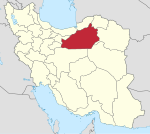
Semnan province is one of the 31 provinces of Iran. It is in the north of the country. Its capital is the city of Semnan.

Semnan is a city in the Central District of Semnan County, Semnan province, Iran, serving as capital of the province, the county and the district. The city is on the alluvial fan of the Golrudbar creek in the north-central part of the country, 216 km east of Tehran and 640 km west of Mashhad. With a population of 185,129 people in 2016, Semnan is the hub of the Semnani language, a sub-branch of the Iranian languages spoken to the north. It is home to the Semnani ethnic group.
Aradan is a city in the Central District of Aradan County, Semnan province, Iran, serving as capital of both the county and the district.

Garmsar County is in Semnan Province, Iran. Its capital is the city of Garmsar.
Eyvanki is a city in, and the capital of Eyvanki District of Garmsar County, Semnan province, Iran.
Irrigation in Iran covers 89,930 km2 making it the fifth ranked country in terms of irrigated area.
The Central District of Garmsar County is in Semnan province, Iran. Its capital is the city of Garmsar.
Eyvanki District is in Garmsar County, Semnan province, Iran. Its capital is the city of Eyvanki.
Jannatabad is a village in Eyvanki Rural District of Eyvanki District of Garmsar County, Semnan province, Iran.
Howmeh Rural District is in the Central District of Garmsar County, Semnan province, Iran. Its capital is the village of Kardovan.
Lajran Rural District is in the Central District of Garmsar County, Semnan province, Iran. Its capital is the village of Lajran.
Yateri Rural District is in the Central District of Aradan County, Semnan province, Iran. Its capital is the village of Davarabad.
Eyvanki Rural District is in Eyvanki District of Garmsar County, Semnan province, Iran. Its capital is the village of Cheshmeh Nadi.
Kohanabad is a city in, and the capital of, Kohanabad District of Aradan County, Semnan province, Iran. It also serves as the administrative center for Kohanabad Rural District.
Cheshmeh Nadi is a village in, and the capital of, Eyvanki Rural District of Eyvanki District of Garmsar County, Semnan province, Iran.
Kardovan is a village in, and the capital of, Howmeh Rural District of the Central District of Garmsar County, Semnan province, Iran.
Shah Sefid is a village in Howmeh Rural District of the Central District of Garmsar County, Semnan province, Iran.
Karand is a village in Lajran Rural District of the Central District of Garmsar County, Semnan province, Iran.

Lajran is a village in, and the capital of, Lajran Rural District of the Central District of Garmsar County, Semnan province, Iran.
Garmsar Rural District is in Jebalbarez-e Jonubi District of Anbarabad County, Kerman province, Iran. Its capital is the village of Garm Salar Reza.










